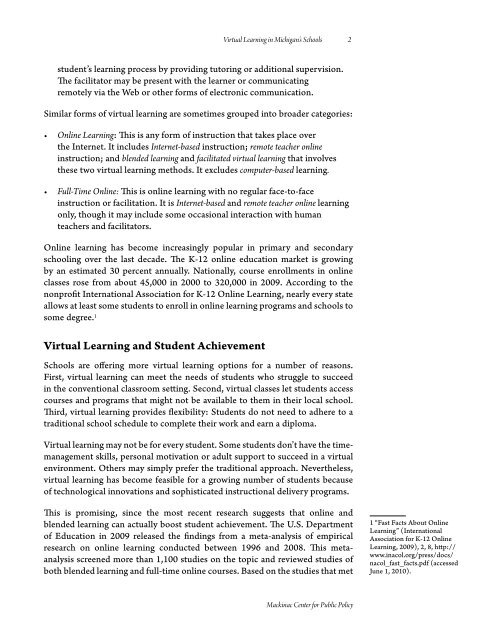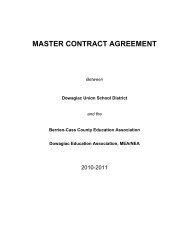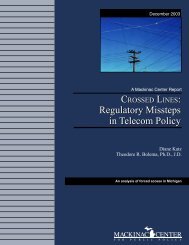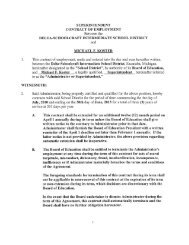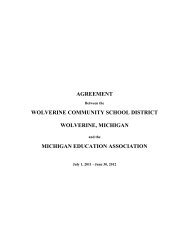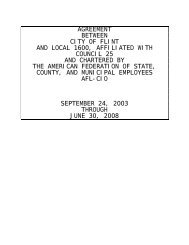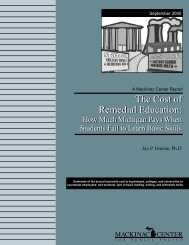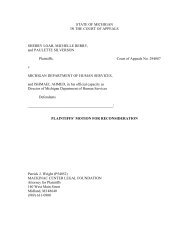<strong>Virtual</strong> Learning in <strong>Michigan</strong>’s Schools 2student’s learning process <strong>by</strong> providing tutoring or additional supervision.The facilitator may be present with the learner or communicatingremotely via the Web or other forms of electronic communication.Similar forms of virtual learning are sometimes grouped into broader categories:• Online Learning: This is any form of instruction that takes place overthe Internet. It includes Internet-based instruction; remote teacher onlineinstruction; and blended learning and facilitated virtual learning that involvesthese two virtual learning methods. It excludes computer-based learning.• Full-Time Online: This is online learning with no regular face-to-faceinstruction or facilitation. It is Internet-based and remote teacher online learningonly, though it may include some occasional interaction with humanteachers and facilitators.Online learning has become increasingly popular in primary and secondaryschooling over the last decade. The K-12 online education market is growing<strong>by</strong> an estimated 30 percent annually. Nationally, course enrollments in onlineclasses rose from about 45,000 in 2000 to 320,000 in 2009. According to thenonprofit International Association for K-12 Online Learning, nearly every stateallows at least some students to enroll in online learning programs and schools tosome degree. 1<strong>Virtual</strong> Learning and Student AchievementSchools are offering more virtual learning options for a number of reasons.First, virtual learning can meet the needs of students who struggle to succeedin the conventional classroom setting. Second, virtual classes let students accesscourses and programs that might not be available to them in their local school.Third, virtual learning provides flexibility: Students do not need to adhere to atraditional school schedule to complete their work and earn a diploma.<strong>Virtual</strong> learning may not be for every student. Some students don’t have the timemanagementskills, personal motivation or adult support to succeed in a virtualenvironment. Others may simply prefer the traditional approach. Nevertheless,virtual learning has become feasible for a growing number of students becauseof technological innovations and sophisticated instructional delivery programs.This is promising, since the most recent research suggests that online andblended learning can actually boost student achievement. The U.S. Departmentof Education in 2009 released the findings from a meta-analysis of empiricalresearch on online learning conducted between 1996 and 2008. This metaanalysisscreened more than 1,100 studies on the topic and reviewed studies ofboth blended learning and full-time online courses. Based on the studies that met1 “Fast Facts About OnlineLearning” (InternationalAssociation for K-12 OnlineLearning, 2009), 2, 8, http://www.inacol.org/press/docs/nacol_fast_facts.pdf (accessedJune 1, 2010).Mackinac Center for Public Policy
<strong>Virtual</strong> Learning in <strong>Michigan</strong>’s Schools 3their rigorous methodological criteria, they concluded, “[O]n average, studentsin online learning conditions performed better than those receiving face-to-faceinstruction.” 2The authors of that study also noted, however, that most of the studies that mettheir criteria came from higher education, professional training or adult learningcourses. 3 Only five of the virtual learning studies that met their criteria dealtspecifically with K-12 education.* For this reason, the authors were reluctant todraw wide-ranging conclusions. Whether virtual learning can produce superiorresults for all students on average in a K-12 environment is yet to be completelydetermined, but there is research that suggests it can at least hold its own againsttraditional instruction.In 2001, Cathy Cavanaugh, an associate professor at the <strong>University</strong> of Floridaand an experienced researcher of online learning, published a meta-analysis ofdistance-learning technologies. Using 19 studies that met her research qualitystandards, Cavanaugh found no statistically significant difference in studentperformance between face-to-face instruction and that provided in a virtualenvironment. 4Results from Florida <strong>Virtual</strong> School — the nation’s largest state “virtual school”— also suggest that students are learning well online. This virtual school providesa variety of online learning courses that are accepted for credit in Florida schooldistricts, and any student in Florida is eligible to enroll. † In 2007, the FloridaTaxWatch Center for Educational Performance and Accountability, a nonprofitresearch group, compared the test scores of students taking Advanced Placementcourses ‡ through FLVS with those taking the courses in Florida’s brick-andmortarschool districts. The average AP test score through FLVS in 2005 was14 percent higher than the average AP test score in conventional public schooldistricts and 11 percent higher than the average AP test score for all Floridastudents, including private and independent schools. 5 In 2006, the FLVS averageAP score increased, while the other scores fell. The FLVS’ AP students scored onaverage 22 percent higher than Florida’s conventional public school students and19 percent higher than all Florida students. §2 Barbara Means et al., “Evaluation of Evidence-Based Practices in Online Learning” (U.S. Department ofEducation, 2009), ix, http://www2.ed.gov/rschstat/eval/tech/evidence-based-practices/finalreport.pdf(accessed Aug. 20, 2009).3 Ibid., xiii.4 Cathy Cavanaugh, “The Effectiveness of Interactive Distance Education Technologies in K-12 Learning:A Meta-Analysis,” International Journal of Educational Telecommunications 7, no. 1 (2001), 81, 83, http://www.coe.ufl.edu/Faculty/cathycavanaugh/docs/CavanaughIJET01.pdf (accessed Jan. 25, 2011).5 “Final Report: A Comprehensive Assessment of Florida <strong>Virtual</strong> School” (Florida TaxWatch, 2007),19-20, goo.gl/7ZRmb (accessed Jan. 13, 2011).* Means et al., “Evaluation ofEvidence-Based Practices in OnlineLearning” (U.S. Department ofEducation, 2009), 32, http://www2.ed.gov/rschstat/eval/tech/evidence-based-practices/finalreport.pdf (accessed Aug. 20,2009). Means et al. use the term“online learning” to describewhat is referred to here as“virtual learning.”† FLVS does not currently grantdiplomas. See “Florida <strong>Virtual</strong>School: Accreditation” (Florida<strong>Virtual</strong> School, 2010), http://www.flvs.net/areas/aboutus/Pages/accreditation.aspx(accessed Jan. 9, 2011); BillTucker, “Florida’s OnlineOption,” Education Next 9,no. 3 (Summer 2009) http://educationnext.org/floridasonline-option/(accessed April5, 2010).‡ Advanced Placement coursesallow students to earn collegecredit in a high school classroom.The courses are approved <strong>by</strong> TheCollege Board and are generallymore rigorous than conventionalclasses. Students take a test atthe end of the course to qualifyfor college credit.§ “Final Report: AComprehensive Assessmentof Florida <strong>Virtual</strong> School”(Florida TaxWatch, 2007),19-20, goo.gl/7ZRmb (accessedJan. 13, 2011). For thesecomparisons, “public schoolstudents” includes studentsenrolled in Florida’s charterand district schools and “allFlorida students” includes theformer plus private school andhome-school students (BettyCoxe, Florida TaxWatch Centerfor Educational Performanceand Accountability, telephonecorrespondence with <strong>Michael</strong><strong>Van</strong> <strong>Beek</strong>, Jan. 12, 2011.)Mackinac Center for Public Policy


